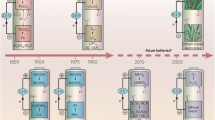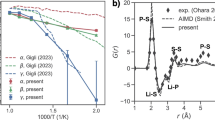Abstract
Although a large number of ionic conductors based on poly(methyl-methacrylate) (PMMA) are reported in literature, an optimization of salt concentration with respect to conductivity and stability properties remains by and large neglected. We report, perhaps for the first time, such an optimization of salt (LiClO4) concentration on structural, morphological, electrical, and ion–polymer interaction in PMMA-based solid polymer films. The active coordination site for the cation (Li+), out of the two possible electron donating functional groups (i.e. C=Ö and Ö–CH3) in PMMA, has been ascertained on the basis of evidences recorded in Fourier transform infrared spectrum. The results suggested C=Ö as the only possible site in PMMA matrix for coordination with Li+ cation. The X-ray diffraction results have clearly indicated an optimum limit of salt dissolution in PMMA matrix corresponding to O/Li = 4 (i.e., ~21wt.%) above which “phase-separation” occurs distinctly. The effect of salt concentration on amorphous → crystalline phase changes in PMMA and its correlation to morphology have been clearly observed in terms of their impact on electrical properties. An optimum electrical conductivity of ~7.2 × 10−5S cm−1 has been recorded at 100°C (~PMMA glass transition). The temperature dependence of conductivity follows typical Vogel–Tamman–Fulcher behavior.









Similar content being viewed by others
References
Ries ME, Brereton MG, Cruickshank JM, Klein PG, Ward I (1995) Macromolecules 28:3282–3289
Hussain R, Mohammad D (2004) Turk J Chem 28:725–729
Chen HW, Lin TP, Chang FC (2002) Polymer 43:5281–5288
Appetecchi GB, Croce F, Scrosati B (1995) Electrochimico Acta 40:991–997
Bohnke O, Frand G, Rezrazi M, Rousselot C, Truche C (1993) Solid State Ionics 66:97–104
Wieczorek W, Stevens JR (1997) J Phys Chem B 101:1529–1534
Ali AMM, Yahya MZA, Bahron H, Subban RHY Harun MK, Atan I (2007) Mater Lett 61:2026–2029
Kumar R, Sharma JP, Sekhon SS (2005) Eur Polym J 41:2718–2725
Rajendran S, Uma T (2000) Bull Mater Sci 23:27–29
Uma T, Mahalingam T, Stimming U (2005) Mater Chem Phys 90:245–249
Ren T, Huang X, Zhao X, Tang X (2003) Mater Sci 38:3007–3011
Stuart BH (2004) Infrared spectroscopy: fundamentals & applications. Wiley, New York
Hummel DO (1966) Infrared spectra of polymers in the medium and long wavelength regions. Wiley, New York
Licoccia S, Trombetta M, Capitani D, Proietti N, Romagnoli P, Vona LD (2005) Polymer 46:4670–4675
Song JY, Wang YY, Wan CC (1999) J Power Sources 77:183–97
Wiecozrek W, Zalewska A, Raducha D, Florjanczyk Z, Stevens JR (1996) Macromolecules 29:143–155
Kim C, Lee G, Lio K, Rhu KS, Kang OSG, Chang SH (1999) Solid State Ionics 123:251–257
Adamec V, Mateova E (1975) Polymer 16:166–168
Druger SD, Ratner MA, Nitzam A (1985) Phys Rev B 31:3939–3947
Miyamoto T, Shibayama K (1973) J Appl Phys 44:5372–5376
Tamman VG, Hesse HZ (1926) Anorg Allg Chem 19:245
Acknowledgment
Authors acknowledge with thanks the financial support received from the Ministry of Human Resource Development (MHRD), Govt. of India, New Delhi for the financial support received vide grant no.: MHRD/RD/F.IV, dated 31st March 2005 for carrying out this piece of research at the Department of Physics & Meteorology, IIT, Kharagpur 721302, INDIA.
Author information
Authors and Affiliations
Corresponding author
Rights and permissions
About this article
Cite this article
Shukla, N., Thakur, A.K. Role of salt concentration on conductivity optimization and structural phase separation in a solid polymer electrolyte based on PMMA-LiClO4 . Ionics 15, 357–367 (2009). https://doi.org/10.1007/s11581-008-0275-3
Received:
Accepted:
Published:
Issue Date:
DOI: https://doi.org/10.1007/s11581-008-0275-3




